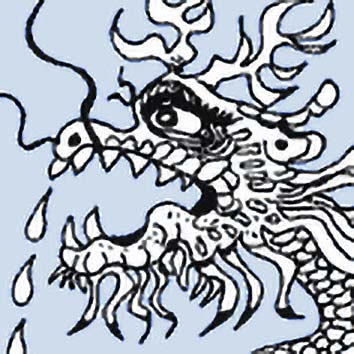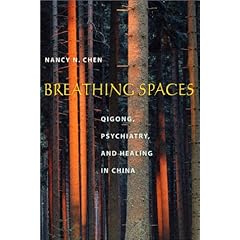Daoism has always maintained its roots to the shamanic and ecstatic worlds and at the same time used them do distinguish itself. Orthodox Daoist's do not practice any martial arts yet Daoists use swords in ritual dance and summon demon armies.
Ancient martial arts traditions are surely an important influence in the development of Daoism, and Daoism has continued to spin-off inspirations for martial arts. I have a bunch of posts dealing with this that I'm working on, but let me start by addressing an interesting quote that "adz" left in the comments sections of my posts on standing.
For me standing is a very active practice (as bizarre as that sounds to some folk). There are so many different aspects that can be worked, but Yao ZhongXun has already said it much better than what I ever could: Training of the mind alone is not Yiquan as is not physical practice alone. The two must be combined. The essence can only be cultivated by integration of the mind and body. Visualization or mental imagery must be employed in relaxed standing (Zhan Zhuang) to direct an integrated neuromuscular coordination that results in a whole-body response. Kinesthetic perception of the internal/external opposing force pairs (Zheng Li) and internal isometrics is developed to seek, sense, experience, cultivate, understand and master the whole-body balanced force (Hun Yuan Li).
This secular attempt to describe jindan (the golden elixir meditation) runs into the same problems Mantak Chia did.
In Taijiquan it is standard to learn "peng, ji, lu, and an" as four separate internal changes and then put them together in a seamless circular motion. The circles then become smaller and smaller. In Xingyi a very similar method is used in, for instance, the metal element to create cutting movement which resembles a forward moving skill-saw-blade.
Wang Xiangzai, the founder of the Yiquan system mentioned above in the quote, may have developed his method from Xingyi. One practice we do in Yiquan is to stand like we are holding a tree. We then move the imaginary tree imperceptibly up-down, left-right, forward-back, and inward-outward. Like taijiquan, this individual training eventually becomes a seamless movement and what starts as small circles becomes smaller and smaller until we can integrate these small circles into our larger movements. We then have power in all directions.
It is a stretch to call this meditation or standing still, no? My friend was joking that it is meditation for people with Attention Deficit Disorder (A.D.D.).
(Here I go digging myself a whole so deep I can't possibly dig myself out in one post.)
In Acupuncture we call the first needle, "calling the qi to order." In Daoist ritual the first act is also called, "calling the qi to order." To call the qi to order one must first invoke the Perfected Warrior, Zhen Wu. This is done by standing still using the physicality of the method described above. It is a totally ready stance--able to instantaneously issue force in all directions.
But Zhen Wu is not just a physicality, he is a whole way of seeing the world, and he is the first stage in the practice of jindan (golden elixir) (Daoist ritual was totally integrated into a solo meditation system during the Tang Dynasty, 600 CE.)
Zhen Wu is visualized in his armor with skin like the night sky drawing inward, chain and silk is woven into his hair. He has bare feet and he is energetically on the edge of his seat. Think of him as holding a sword in one hand, without a sheath, the tip of the blade is dragging on the ground. He is the embodiment of the taijiquan concept song (or sung, let go, sink) he is utterly fearless, the god of nothing-to-lose.
This is stage one. Don't get me wrong, stage one is cool. But these secularists have no way to deal with stage two, and no coherent explanation of fruition. (Perhaps we should have an old-folks home especially for people who can issue power in all directions at once.)
UPDATE: the quote about mentions "whole body balanced force," when I wrote this ten years ago I didn't know what that was. Now I teach it! But I call it the six dimensions and three thresholds of counterbalancing.
 Still, I developed the ability to see and correct alignment problems, and to spontaneously create simple exercises that release tension and increase mobility in joints. This ability is a kind of intuition.
Still, I developed the ability to see and correct alignment problems, and to spontaneously create simple exercises that release tension and increase mobility in joints. This ability is a kind of intuition.
 The reason for discipline is to make a practice irreversible.
The reason for discipline is to make a practice irreversible. For example, the Kitchen God lives over the stove in Chinese homes. He represents an irreversible commitment to keep the house clean. The method is cleaning on a regular schedule. When cleaning becomes "second nature" the method can become more spontaneous, but it can't really be dropped. The fruition is living in a cleaner, simpler, healthier environment, where things are easy to find, easy to store, and easy to get rid of.
For example, the Kitchen God lives over the stove in Chinese homes. He represents an irreversible commitment to keep the house clean. The method is cleaning on a regular schedule. When cleaning becomes "second nature" the method can become more spontaneous, but it can't really be dropped. The fruition is living in a cleaner, simpler, healthier environment, where things are easy to find, easy to store, and easy to get rid of. Most Daoist inspired methods reveal something about your true nature. Often it is an appetite of some kind. The most obvious example is that sitting or standing practices reveal an appetite for stillness. After about two years of discipline your appetite should be strong enough to direct your practice, rigid or militaristic discipline will actually hold you back. I know my morning standing practice is irreversible because if some anomaly or emergency disrupts my practice, the rest of the day I feel myself being pulled toward stillness--At the end of the day I jump into bed and savor the thought of waking up to my practice.
Most Daoist inspired methods reveal something about your true nature. Often it is an appetite of some kind. The most obvious example is that sitting or standing practices reveal an appetite for stillness. After about two years of discipline your appetite should be strong enough to direct your practice, rigid or militaristic discipline will actually hold you back. I know my morning standing practice is irreversible because if some anomaly or emergency disrupts my practice, the rest of the day I feel myself being pulled toward stillness--At the end of the day I jump into bed and savor the thought of waking up to my practice.

 One of the biggest challenges of being a teacher is that students are always trying to get me to equivocate. For instance, I say, "Practice standing completely still for one hour early in the morning, everyday, before you eat breakfast."
One of the biggest challenges of being a teacher is that students are always trying to get me to equivocate. For instance, I say, "Practice standing completely still for one hour early in the morning, everyday, before you eat breakfast." Chinese Martial arts and Qigong from a Daoist point of view are non-transcendent traditions.
Chinese Martial arts and Qigong from a Daoist point of view are non-transcendent traditions.
 I took the following quote from Joanna Zorya at
I took the following quote from Joanna Zorya at  Elisabeth Hsu wrote an article in
Elisabeth Hsu wrote an article in 
 Nancy N. Chen's book
Nancy N. Chen's book  sometime in the late 80's. It turned out to be, at least partly, what we had all been practicing and referring to as martial arts warm-ups. But there where also lots of claims being attached to this new "qigong" that didn't seem to fit our experiences. There was a lot of religious feeling and parlor tricks too. There were strange and sometimes very specific claims made about healing powers associated with both the practice of doing qigong and these new "Masters" themselves.
sometime in the late 80's. It turned out to be, at least partly, what we had all been practicing and referring to as martial arts warm-ups. But there where also lots of claims being attached to this new "qigong" that didn't seem to fit our experiences. There was a lot of religious feeling and parlor tricks too. There were strange and sometimes very specific claims made about healing powers associated with both the practice of doing qigong and these new "Masters" themselves.